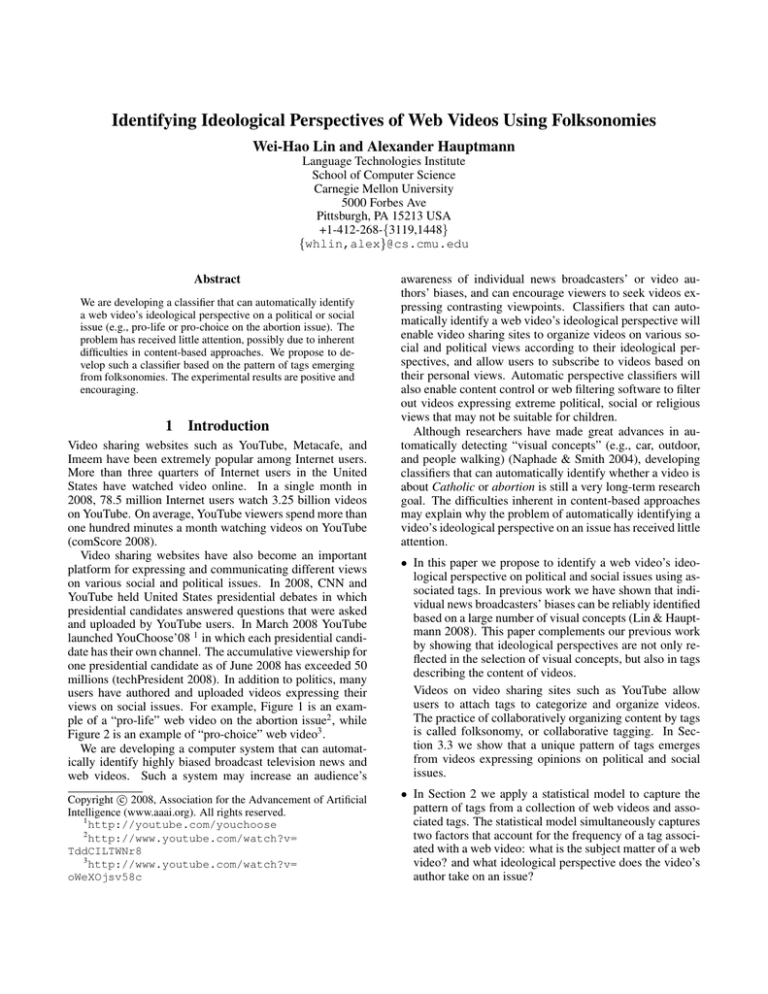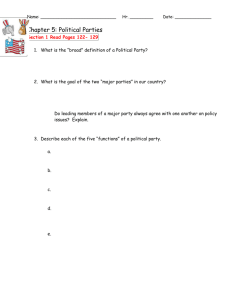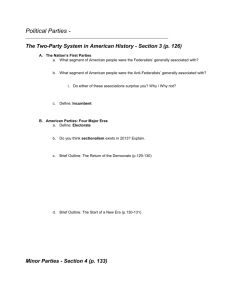
Identifying Ideological Perspectives of Web Videos Using Folksonomies
Wei-Hao Lin and Alexander Hauptmann
Language Technologies Institute
School of Computer Science
Carnegie Mellon University
5000 Forbes Ave
Pittsburgh, PA 15213 USA
+1-412-268-{3119,1448}
{whlin,alex}@cs.cmu.edu
Abstract
We are developing a classifier that can automatically identify
a web video’s ideological perspective on a political or social
issue (e.g., pro-life or pro-choice on the abortion issue). The
problem has received little attention, possibly due to inherent
difficulties in content-based approaches. We propose to develop such a classifier based on the pattern of tags emerging
from folksonomies. The experimental results are positive and
encouraging.
1
Introduction
Video sharing websites such as YouTube, Metacafe, and
Imeem have been extremely popular among Internet users.
More than three quarters of Internet users in the United
States have watched video online. In a single month in
2008, 78.5 million Internet users watch 3.25 billion videos
on YouTube. On average, YouTube viewers spend more than
one hundred minutes a month watching videos on YouTube
(comScore 2008).
Video sharing websites have also become an important
platform for expressing and communicating different views
on various social and political issues. In 2008, CNN and
YouTube held United States presidential debates in which
presidential candidates answered questions that were asked
and uploaded by YouTube users. In March 2008 YouTube
launched YouChoose’08 1 in which each presidential candidate has their own channel. The accumulative viewership for
one presidential candidate as of June 2008 has exceeded 50
millions (techPresident 2008). In addition to politics, many
users have authored and uploaded videos expressing their
views on social issues. For example, Figure 1 is an example of a “pro-life” web video on the abortion issue2 , while
Figure 2 is an example of “pro-choice” web video3 .
We are developing a computer system that can automatically identify highly biased broadcast television news and
web videos. Such a system may increase an audience’s
c 2008, Association for the Advancement of Artificial
Copyright Intelligence (www.aaai.org). All rights reserved.
1
http://youtube.com/youchoose
2
http://www.youtube.com/watch?v=
TddCILTWNr8
3
http://www.youtube.com/watch?v=
oWeXOjsv58c
awareness of individual news broadcasters’ or video authors’ biases, and can encourage viewers to seek videos expressing contrasting viewpoints. Classifiers that can automatically identify a web video’s ideological perspective will
enable video sharing sites to organize videos on various social and political views according to their ideological perspectives, and allow users to subscribe to videos based on
their personal views. Automatic perspective classifiers will
also enable content control or web filtering software to filter
out videos expressing extreme political, social or religious
views that may not be suitable for children.
Although researchers have made great advances in automatically detecting “visual concepts” (e.g., car, outdoor,
and people walking) (Naphade & Smith 2004), developing
classifiers that can automatically identify whether a video is
about Catholic or abortion is still a very long-term research
goal. The difficulties inherent in content-based approaches
may explain why the problem of automatically identifying a
video’s ideological perspective on an issue has received little
attention.
• In this paper we propose to identify a web video’s ideological perspective on political and social issues using associated tags. In previous work we have shown that individual news broadcasters’ biases can be reliably identified
based on a large number of visual concepts (Lin & Hauptmann 2008). This paper complements our previous work
by showing that ideological perspectives are not only reflected in the selection of visual concepts, but also in tags
describing the content of videos.
Videos on video sharing sites such as YouTube allow
users to attach tags to categorize and organize videos.
The practice of collaboratively organizing content by tags
is called folksonomy, or collaborative tagging. In Section 3.3 we show that a unique pattern of tags emerges
from videos expressing opinions on political and social
issues.
• In Section 2 we apply a statistical model to capture the
pattern of tags from a collection of web videos and associated tags. The statistical model simultaneously captures
two factors that account for the frequency of a tag associated with a web video: what is the subject matter of a web
video? and what ideological perspective does the video’s
author take on an issue?
Figure 1: The key frames of a web video expressing a “pro-life” view on the abortion issue, which is tagged with prayer,
pro-life, and God.
Figure 2: The key frames of a web video expressing a “pro-choice” view on the abortion issue, which is tagged with pro,
choice, feminism, abortion, women, rights, truth, Bush.
two sets of weights combined.
V2
We apply a statistical model to capture how web videos
expressing strongly a particular ideological perspective are
tagged. The statistical model, called the Joint Topic and Perspective Model (Lin, Xing, & Hauptmann 2008), is designed
to capture an emphatic pattern empirically observed in many
ideological texts (editorials, debate transcripts) and videos
(broadcast news videos). We hypothesize that the tags associated with web videos on various political and social issues
also follow the same emphatic pattern.
The emphatic pattern consists of two factors that govern the content of ideological discourse: topical and ideological. For example, in the videos on the abortion issue, tags such as abortion and pregnancy are expected
to occur frequently no matter what ideological perspective
a web video’s author takes on the abortion issue. These
tags are called topical, capturing what an issue is about.
In contrast, the occurrences of tags such as pro-life
and pro-choice vary much depend on a video author’s
view on the abortion issue. These tags are emphasized (i.e.,
tagged more frequently) on one side and de-emphasized
(i.e., tagged less frequently) on the other side. These tags
are called ideological.
The Joint Topic and Perspective Model assigns topical
and ideological weights to each tag. The topical weight of a
tag captures how frequently the tag is chosen because of an
issue. The ideological weight of a tag represents to what degree the tag is emphasized by a video author’s ideology on
an issue. The Joint Topic and Perspective Model assumes
that the observed frequency of a tag is governed by these
ch
Joint Topic and Perspective Model
ion
2
ort
oic
ab
e
• We evaluate the idea of using associated tags to classify
a web video’s ideological perspective on an issue in Section 3. The experimental results in Section 3.2 are very
encouraging, suggesting that Internet users holding similar ideological beliefs upload, share, and tag web videos
similarly.
T
V1
life
Figure 3: A three tag simplex illustrates the main idea behind the Joint Topic and Perspective Model. T denotes the
proportion of the three tags (i.e., topical weights) that are
chosen for a particular issue (e.g., abortion). V1 denotes
the proportion of the three tags after the topical weights are
modulated by video authors holding the “pro-life” view; V2
denotes the proportion of the three tags modulated by video
authors holding the contrasting “pro-choice” view.
We illustrate the main idea of the Joint Topic and Perspective Model in a three tag world in Figure 3. Any point
in the three tag simplex represents the proportion of three
tags (e.g., abortion, life, and choice) chosen in web
videos about the abortion issue (also known as a multinomial distribution’s parameter). T represents how likely we
would be to see abortion, life, and choice in web
videos about the abortion issue. Suppose a group of web
video authors holding the “pro-life” perspective choose to
produce and tag more life and fewer choice. The ideological weights associated with this “pro-life” group in effect move the proportion from T to V1 . When we sample
tags from a multinomial distribution of a parameter at V1 ,
we would see more life and fewer choice tags. In contrast, suppose a group of web video authors holding the “pro-
choice” perspective choose to make and tag more choice
and fewer life. The ideological weights associated with
this “pro-choice” group in effect move the proportion from
T to V2 . When we sample tags from a multinomial distribution of a parameter at V2 , we would see more life and
fewer choice tags. The topical weights determine the position of T in a simplex, and each ideological perspective
moves T to a biased position according to its ideological
weights.
We can fit the Joint Topic and Perspective Model on data
to simultaneously uncover topical and ideological weights.
These weights succinctly summarize the emphatic patterns
of tags associated with web videos about an issue. Moreover, we can apply the weights learned from training videos,
and predict the ideological perspective of a new web video
based on associated tags.
2.1
Model Specification and Predicting
Ideological Perspectives
μτ
τ
π
The ideological perspective Pd from which the d-th web
video in a collection was produced (i.e., its author or
uploader’s ideological perspective) is assumed to be a
Bernoulli variable with a parameter π. In this paper, we focus on bipolar ideological perspectives, that is, those political and social issues with only two perspectives of interest
(V = 2). There are a total of D web videos in the collection. The n-th tag in the d-th web video Wd,n is dependent
on its author’s ideological perspective Pd and assumed to be
sampled from the multinomial distribution of a parameter β.
There are a total of Nd tags associated with the d-th web
video.
τ represents the topical weights and is assumed to be sampled from a multivariate normal distribution of a mean vector μτ and a variance matrix Στ . φv represents the ideological weights and is assumed to be sampled from a multivariate normal distribution of a mean vector μφ and a variance
matrix Στ . Every tag is associated with one topical weight
w
τ w and two ideological weights φw
1 and φ2 . Topical weights
are modulated by ideological weights through a multiplicative relationship, and all the weights are normalized through
a logistic transformation. The graphical representation of
the Joint Topic and Perspective Model is shown in Figure 4.
Given a set of D documents on a particular topic from
differing ideological perspectives {Pd }, the joint posterior probability distribution of the topical and ideological
Wd,n
Στ
βv
Nd
V
μφ
φv
V
D
Σφ
Figure 4: A Joint Topic and Perspective model in a graphical
model representation. A dashed line denotes a deterministic
relation between parents and children nodes.
weights under the Joint Topic and Perspective model is
P (τ, {φv }|{Wd,n }, {Pd }; Θ)
∝P (τ |μτ , Στ )
P (φv |μφ , Σφ )
v
Formally, the Joint Topic and Perspective Model assumes
the following generative process for the tags associated with
web videos:
Pd ∼ Bernoulli(π), d = 1, . . . , D
Wd,n |Pd = v ∼ Multinomial(βv ), n = 1, . . . , Nd
exp(τ w × φw
v)
βvw = , v = 1, . . . , V
w
× φw
v )
w exp(τ
τ ∼ N(μτ , Στ )
φv ∼ N(μφ , Σφ ).
Pd
Nd
P (Pd |π)
d=1
P (Wd,n |Pd , τ, {φv })
n=1
= N(τ |μτ , Στ )
D
N(φv |μφ , Σφ )
v
Bernoulli(Pd |π)
d
Multinomial(Wd,n |Pd , β),
n
where N (·), Bernoulli(·) and Multinomial(·) are the probability density functions of multivariate normal, Bernoulli,
and multinomial distributions, respectively.
The joint posterior probability distribution of τ and {φv },
however, are computationally intractable because of the nonconjugacy of the logistic-normal prior. We have developed
an approximate inference algorithm (Lin, Xing, & Hauptmann 2008). The approximate inference algorithm is based
on variational methods, and parameters are estimated using
variational Expectation Maximization (Attias 2000).
To predict a web video’s ideological perspective P˜d is to
calculate the following conditional probability,
P (P˜d |{Pd }, {Wd,n }, {W̃n }; Θ)
=
P ({φv }, τ |{Pd }, {Wd,n }, {W̃n }; Θ)
P (P˜d |{W̃n }, τ, {φv }; Θ)dτ dφv
(1)
Due to the non-conjugacy between normal and multinomial distributions, exact inference on the Joint Topic and
Perspective Model is computationally intractable. An approximate inference algorithm based on variational methods
has been developed in (Lin, Xing, & Hauptmann 2008).
3
3.1
Experiments
Data
We collected web videos expressing opinions on various political and social issues from YouTube4 . To identify web
4
http://www.youtube.com/.
1.0
random
jTP
0.7
0.6
0.4
0.5
accuracy
0.8
0.9
videos expressing a particular ideological perspective on an
issue, we selected “code words” for each ideological perspective, and submitted the code words as query to YouTube.
All of the returned web videos are labeled as expressing the
particular ideological perspective. For example, the query
words for the “pro-life” perspective on the abortion issue
are “pro-life” and “abortion.”
Issue
Abortion
Democratic party
primary election
in 2008
Gay rights
Global warming
Illegal
immigrants to the
United States
Iraq War
Israeli-Palestinian
conflict
United States politics
1
2
3
4
5
6
7
8
View 1
pro-life
pro-Hillary
View 2
pro-choice
pro-Obama
pro-gay
supporter
Legalization
anti-gay
skeptic
Deportation
pro-war
pro-Israeli
anti-war
proPalestinian
proRepublican
proDemocratic
Table 1: Eight political and social issues and their two main
ideological perspectives
We downloaded web videos and associated tags for 16
ideological views in May 2008 (two main ideological perspectives for eight issues), as listed in Table 1. Tags are keywords voluntarily added by authors or uploaders5 . The total
number of downloaded videos and associated tags are shown
in Table 2. Note that the number of downloaded videos is
equal to less than the total number of videos returned by
YouTube due of the limit on the maximum number of search
results in YouTube APIs.
We assume that web videos containing the “code words”
of an ideological perspective in tags or descriptions convey
the particular view, but this assumption may not be true.
YouTube and many web video search engines are so far not
5
http://www.google.com/support/youtube/
bin/answer.py?hl=en&answer=55769
1
2
3
4
5
6
7
8
total videos
2850
1063
1729
2408
2445
2145
1975
2849
total tags
30525
13215
18301
27999
25820
25766
22794
34222
vocabulary
4982
2315
4620
4949
4693
4634
4435
6999
Table 2: The total number of downloaded web videos, the
total number of tags, and the vocabulary size (the number of
unique tags) for each issue
1
2
3
4
5
6
7
8
Issue ID
Figure 5: The accuracies of classifying a web video’s ideological perspective on eight issues
designed to retrieve videos expressing opinions on an issue,
let alone to retrieve videos expressing a particular ideological view using keywords. Moreover, a web video may mention the code words of an ideological perspective in titles,
descriptions, or tags but without expressing any opinions on
an issue. For example, a news clip tagged with “pro-choice”
may simply report a group of pro-choice activists in a protest
and do not express strongly a so-called pro-choice point of
view on the abortion issue.
3.2
Identifying Videos’ Ideological Perspectives
We evaluated how well a web video’s ideological perspective can be identified based on associated tags in a classification task. For each issue, we trained a binary classifier based
on the Joint Topic and Perspective model in Section 2, and
applied the classifier on a held-out set. We reported the average accuracy of the 10-fold cross-validation. We compared
the classification accuracy using the Joint Topic and Perspective Model with a baseline that randomly guesses one
of two ideological perspectives. The accuracy of a random
baseline is close but not necessarily equal to 50% because
the number of videos in each ideological perspective on an
issue are not necessarily equivalent.
The experimental results in Figure 5 are very encouraging. The classifiers based on the Joint Topic and Perspective
Model (labeled as jTP in Figure 5) outperform the random
baselines for all eight political and social issues. The positive results suggest that the ideological perspectives of web
videos can be identified using associated tags. Note that because the labels of our data are noisy, the results should be
considered as a lower bound. The actual performance may
be further improved if less noisy labels are available.
The positive classification results also suggest that Internet users sharing similar ideological beliefs on an issue
appear to author, upload, and share similar videos, or at
least, to tag similarly. Given that these web videos are uploaded and tagged at different times without coordination, it
is surprising to see any pattern of tags emerging from folksonomies of web videos on political and social issues. Although the theory of ideology has argued that people sharing similar ideological beliefs use similar rhetorical devices
for expressing their opinions in the mass media (Van Dijk
1998), we are the first to observe this pattern of tags in user-
generated videos.
The non-trivial classification accuracy achieved by the
Joint Topic and Perspectives Model suggests that the statistical model seem to closely match the real data. Although the
Joint Topic and Perspective Model makes several modeling
assumptions, including a strong assumption on the independence between tags (through a multinomial distribution), the
high classification accuracy supports that these assumptions
are not violated by the real data too much.
3.3
Patterns of Tags Emerging from
Folksonomies
We illustrate the patterns of tags uncovered by the Joint
Topic and Perspective Model in Figure 6 and Figure 7. We
show only tags that occur more than 50 times in the collection. Recall that the Joint Topic and Perspective Model
simultaneously learns the topical weights τ (how frequently
a word is tagged in web videos on an issue) and ideological
weights φ (how frequently a tag is emphasized by a particular ideological perspective). We summarize these weights
and tags in a color text cloud, where a word’s size is correlated with the tag’s topical weight, and a word’s color is
correlated with the tag’s ideological weight. Tags not particularly emphasized by either ideological perspectives are
painted light gray.
The tags with large topical weights appear to represent the subject matter of an issue. The tags with large
topical weights on the abortion issue in Figure 6 include
abortion, pro life, and pro choice, which are the
main topic and two main ideologies. The tags with large topical weights on the global warming issue in Figure 7 include
global warming, Al Gore and climate change.
Interestingly, tags with large topical weights are usually not
particularly emphasized by either of the ideological views
on an issue.
The tags with large ideological weights appear to closely
represent each ideological perspective. Users holding the
pro-life beliefs on the abortion issue (red in Figure 6) upload and tag more videos about unborn baby and religion (Catholic, Jesus, Christian, God). In contrast, users holding the pro-choice beliefs on the abortion issue (blue in Figure 6) upload more videos about
women’s rights (women, rights, freedom) and atheism
(atheist). Users who acknowledge the crisis of global
warming (red in Figure 7) uploads more videos about energy
(renewable energy, oil, alternative), recycling
(recycle, sustainable), and pollution (pollution,
coal, emissions). In contrast, users skeptical about
global warming upload more videos that criticize global
warming (hoax, scam, swindle) and suspect it is a conspiracy (NWO, New World Order).
We do not intend to give a full analysis of why each ideology chooses and emphasizes these tags, but to stress that
folksonomies of the ideological videos on the Internet are a
rich resource to be tapped. Our experimental results in Section 3.2 and the analysis in this section show that by learning
patterns of tags associated with web videos, we can identify
web videos’ ideological perspectives on various political and
social issues with high accuracy.
catholic music for
march
prolife
babies christian paul to
baby god unborn ron jesus anti
life
parenthood
abortion
planned right of silent republican
child
fetus pregnancy abortions
death embryo murder
pro
president election the
pregnant news clinton political
choice
religion 2008 bible romney aborto
debate politics birth mccain rights atheist
obama wade roe women freedom feminism womens
prochoice
Figure 6: The color text cloud summarizes the topical and
ideological weights learned in the web videos expressing
contrasting ideological perspectives on the abortion issue.
The larger a word’s size, the larger its topical weight. The
darker a word’s color shade, the more extreme its ideological
weight. Red represents the pro-life ideology, and blue represents the pro-choice ideology. The words are ordered by
ideological weights, from strongly pro-life (red) to strongly
pro-choice (blue).
pollution energy green environment oil eco gas
renewable nature conservation coal ecology health
sustainable air globalwarming water recycle
environmental emissions planet alternative solar
comedy bbc politics 2008 democrats sea polar save
power earth day the sustainability war ice mccain
clinton greenhouse clean tv fuel edwards election
social house melting on carbon david live music
change
obama
car
climate
michael richard peace
global warming
commercial video
news
sun to greenpeace hot
bush un hillary funny of gotcha
documentary political president co2 al gore
an effect inconvenient grassroots john
government dioxide commentary in george analysis
outreach truth nonprofit canada weather public jones
media alex kyoto new tax beck robert debate
science
skeptic crisis
swindle hoax scam
nwo paul
fraud order god great false abc is
exposed invalid lies bosneanu sorin
world
Figure 7: The color text cloud summarizes the topical and
ideological weights learned in the web videos expressing
contrasting ideological perspectives on the global warming
issue. The larger a word’s size, the larger its topical weight.
The darker a word’s color shade, the more extreme its ideological weight. Red represents the ideology of global warming supporters, and blue represents the ideology of global
warming skeptics. The words are ordered by ideological
weights, from strongly supporting global warming (red) to
strongly skeptical about global warming (blue).
Folksonomies mined from video sharing sites such as
YouTube contain up-to-date information that other resources
may lack. Due to the data collection time coinciding with the
United States presidential election, many videos are related
to presidential candidates and their views on various issues.
The names of presidential candidates occur often in tags, and
their views on various social and political issues become discriminative features (e.g., Ron Paul’s pro-life position on
the abortion issue in Figure 6). Ideological perspective classifiers should build on folksonomies of web videos to take
advantage of these discriminative features. Classifiers built
on static resources may fail to recognize these current, but
very discriminative, tags.
4
Related Work
We borrow statistically modeling and inference techniques
heavily from research on topic modeling (e.g., (Hofmann
1999), (Blei, Ng, & Jordan 2003) and (Griffiths & Steyvers
2004)). They focus mostly on modeling text collections
that containing many different (latent) topics (e.g., academic
conference papers, news articles, etc). In contrast, we are
interested in modeling ideology texts that are mostly on the
same topic but mainly differs in their ideological perspectives. There have been studies going beyond topics (e.g.,
modeling authors (Rosen-Zvi et al. 2004)). In this paper we
are interested in modeling lexical variation collectively from
multiple authors sharing similar beliefs, not lexical variations due to individual authors’ writing styles and topic preference.
5
Conclusion
We propose to identify the ideological perspective of a web
video on an issue using associated tags. We show that the
statistical patterns of tags emerging from folksonomies can
be successfully learned by a Joint Topic and Perspective
Model, and the ideological perspectives of web videos on
various political and social issues can be automatically identified with high accuracy. Web search engines and many
Web 2.0 applications can incorporate our method to organize and retrieve web videos based on their ideological perspectives on an issue.
Acknowledgements
We would like to thank the anonymous reviewers for their
valuable suggestions. This work was supported in part by
the National Science Foundation (NSF) under Grants No.
IIS-0535056 and CNS-0751185
References
Attias, H. 2000. A variational bayesian framework for
graphical models. In Advances in Neural Information Processing Systems 12.
Blei, D. M.; Ng, A. Y.; and Jordan, M. 2003. Latent
Dirichlet allocation. Journal of Machine Learning Research 3:993–1022.
comScore.
2008.
YouTube.com accounted for
1 out of every 3 u.s. online videso viewed in
january.
http://www.comscore.com/press/
release.asp?press=2111Please.
Griffiths, T. L., and Steyvers, M. 2004. Finding scientific
topics. Proceedings of the National Academy of Sciences
101:5228–5235.
Hofmann, T. 1999. Probabilistic latent semantic indexing. In Proceedings of the 22nd Annual International ACM
SIGIR Conference on Research and Development in Information Retrieval, 50–57.
Lin, W.-H., and Hauptmann, A. 2008. Do these news
videos portray a news event from different ideological perspectives? In Proceedings of the Second IEEE International Conference on Semantic Computing.
Lin, W.-H.; Xing, E.; and Hauptmann, A. 2008. A joint
topic and perspective model for ideological discourse. In
Proceedings of the 2008 European Conference on Machine
Learning and Principles (ECML) and Practice of Knowledge Discovery in Databases (PKDD).
Naphade, M. R., and Smith, J. R. 2004. On the detection
of semantic concepts at TRECVID. In Proceedings of the
Twelfth ACM International Conference on Multimedia.
Rosen-Zvi, M.; Griffths, T.; Steyvers, M.; and Smyth, P.
2004. The author-topic model for authors and documents.
In Proceedings of the 20th Conference on Unvertainty in
Artificial Intelligence.
techPresident. 2008. YouTube stats. http://www.
techpresident.com/youtube.
Van Dijk, T. A. 1998. Ideology: A Multidisciplinary Approach. Sage Publications.







